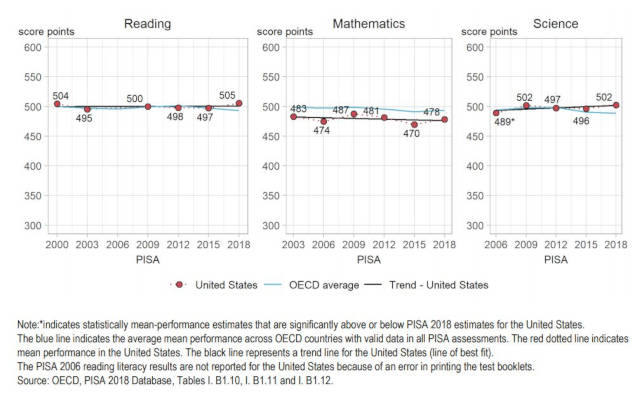PISA: U.S. Students Flat in Math and Science
- By Dian Schaffhauser
- 12/05/19
The 2018 PISA results are out, and the picture they portray for the United States could only be called fair to middlin'. On a scale of zero to 1,000, American students performed above the OECD average in reading (505 points versus an average of 487) and science (502, compared to an average of 489) and below the OECD average in mathematics (478, against an OECD average of 489). As the results noted, the trend lines of the U.S. mean performance for math since 2003 and science since 2006 were stable, "with no significant improvement or decline." In reading, on the other hand, the share of test-takers who scored at levels 5 or 6 (the top ranks) grew by almost four percentage points — considered a "statistically significant increase" — between 2009 and 2018 — to 13.5 percent.
The Programme for International Student Assessment (PISA) examines what 15-year-old students know in reading, math and science, and what they can do with what they know. It's sponsored by the Organisation for Economic Co-operation and Development (OECD). The 2018 assessment was taken by 600,000 students (representing some 32 million) in 79 countries or economies. In the United States 4,838 students in 215 schools finished the two-hour assessment, representing 3.56 million students (about 86 percent of the total population of 15-year-olds in the country).
In reading, the United States landed in 13th place, coming in at a level three of four levels. At the top of that ranking was China (and specifically, Beijing, Shanghai, Jiangsu and Zhejiang or "B-S-J-Z") with a mean score of 555, the only country to achieve level four — the highest — for reading.

PISA trends in performance in reading, math and science for U.S. students. Source: "United States - Country Note - PISA 2018 Results," from the OECD.
For science, China's B-S-J-Z was, again, the only country to achieve the level four category. The United States, in 18th place, surfaced in level three.
In math China grabbed three of four spots for level four, including B-S-J-Z, Macao and Hong Kong. Singapore was the fourth country to make the level four cut. With a mean score of 478, the United States landed at level two, in 37th place.
The U.S. results found that — as in many other participating countries — students with economic advantages here outperformed those without the advantages. For reading, the "performance gap" between learners who were "socio-economically advantaged" and those who weren't was 99 points. (The OECD average was 89 points.)
The results also exposed gender gaps. American girls outperformed American boys by 24 points for reading, while boys outdid girls by nine points in math. (Across all countries that participated, in fact, girls beat the boys in reading by 30 points.) In science, both sexes performed comparably.
Through optional questions that asked students about aspects of their lives, the assessment also found out that three in ten boys who fell into the "high-performing" segment for math or science reported that they expected to work as an engineer or science professional by the age of 30, while only one in 10 girls said the same.
In addition, "sizable" numbers of those who performed poorly expressed "ambitious expectations" about future education. More than three-quarters of U.S. students told researchers they expected to attain a college education, compared to less than half (48 percent) across other OECD countries.
U.S. students reported "significantly more competition than cooperation" among their peers "to a greater degree" than those students in any other PISA-participating country. Across the board, internationally, students whose peers cooperated the most tended to score about 50 points higher in reading than students whose peers cooperated the least.
The topic of a growth mindset surfaced as a key finding for the United States. Those students who agreed with the statement, "Your intelligence is something about you that you can't change very much," scored 58 points lower in reading than those who disagreed.
The PISA results, sliced and diced and interpreted in multiple formats, is openly available on the OECD website.
About the Author
Dian Schaffhauser is a former senior contributing editor for 1105 Media's education publications THE Journal, Campus Technology and Spaces4Learning.